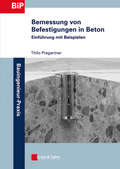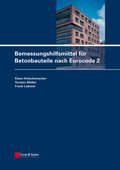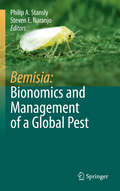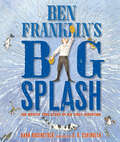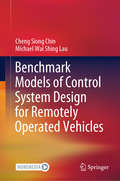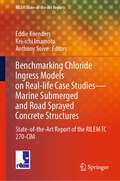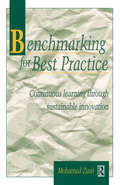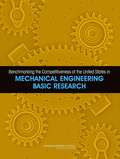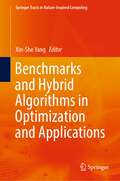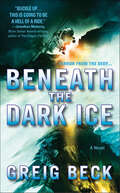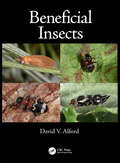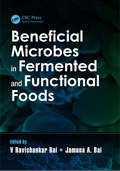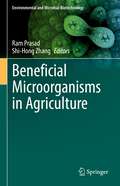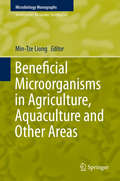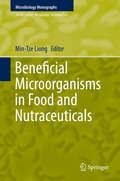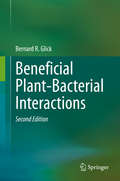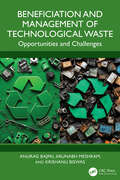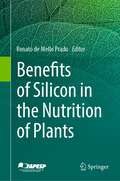- Table View
- List View
Bemessung von Befestigungen in Beton: Einführung mit Beispielen (Bauingenieur-Praxis)
by Thilo PregartnerThe design of fixings in concrete is in practice almost exclusively performed with programs provided by manufacturers. For the interpretation of the results and to deal with any application case, this book offers explanations about the design procedure.
Bemessungshilfsmittel für Betonbauteile nach Eurocode 2
by Klaus Holschemacher Torsten Müller Frank LobischThe daily work of engineers, for preliminary design and to check plausibility, would be inconceivable without them: design aids for reinforced concrete elements in the form of diagrams and tables. Now newly revised to cover Eurocode 2.
Bemisia: Bionomics And Management Of A Global Pest
by Philip A. Stansly Steven E. NaranjoBemisia tabaci (Gennedius) has distinguished itself from the more than 1,000 whitefly species in the world by its adaptability, persistence and potential to damage a wide range of agricultural and horticultural crops in all six of the world's inhabited continents. B. tabaci inflicts plant damage through direct feeding, inducement of plant disorders, vectoring of plant viruses and excretion of honeydew. This book collates multiple aspects of the pest ranging from basic to applied science and molecular to landscape levels of investigation. Experts in multiple disciplines provide broad, but detailed summaries and discussion of taxonomy, genetics, anatomy, morphology, physiology, behavior, ecology, symbiotic relationships, virus vector associations and various tactics for integrated management of this pest insect. The book is focused primarily on progress during the last 10-15 years and is directed at workers in the field as well as the informed professional who may not necessarily specialize in whitefly research. The book is unique in providing broad coverage in relatively few chapters by recognized experts that highlight the state-of-the-art in our understanding of this fascinating but troublesome cosmopolitan pest.
Ben Franklin's Big Splash: The Mostly True Story of His First Invention
by Barb RosenstockA National Science Teachers Association, Best STEM BookHere is the story of Ben Franklin's first invention, his journey through the scientific method, and the surprising successes that result when you're willing to make mistakes.Every inventor has to start somewhere, and one of the greatest innovators in our history was no exception. Ben Franklin developed his first invention while doing what he loved best: swimming! Barb Rosenstock's rhythmic, whimsical style is the perfect complement to S. D. Schindler's pen and ink and watercolor illustrations. Together they recreate history in an engaging and unique way. Both author and illustrator worked closely with Franklin experts, and the book includes Franklin quotes, an extensive author's note, timeline, and bibliography.
Benchmark Models of Control System Design for Remotely Operated Vehicles
by Cheng Siong Chin Michael Wai LauThis book is intended to meet the needs of those who seek to develop control systems for ROVs when there is no model available during the initial design stage. The modeling, simulation and application of marine vehicles like underwater robotic vehicles (URVs) are multidisciplinary, and combine mathematical aspects from various engineering disciplines. URVs such as remotely operated vehicle (ROVs) are used for a wide range of applications such as exploring the extreme depths of our ocean, where a hard-wired link is still required. Most ROVs operate in extreme environments with uncertainties in the model prior to control system design. However, the method involved extensive testing before the system model could be used for any control actions. It has been found that the range of error can be extensive and uncertain in actual, continuously varying conditions. Hence, it is important to address the problem of reliance on model testing using different modeling approaches. In this book, approaches such as WAMIT, ANSYS-CFX, STAR CCM+, MATLAB and Simulink are used to model parameters for ROVs. A few benchmark models are provided, allowing researchers and students to explore and test different control schemes. Given its scope, the book offers a valuable reference guide for postgraduate and undergraduate students engaged in modeling and simulation for ROV control.
Benchmarking Chloride Ingress Models on Real-life Case Studies—Marine Submerged and Road Sprayed Concrete Structures: State-of-the-Art Report of the RILEM TC 270-CIM (RILEM State-of-the-Art Reports #37)
by Eddie Koenders Kei-Ichi Imamoto Anthony SoiveThis book presents the work of RILEM Technical Committee 270-CIM: Benchmarking Chloride Ingress Models on Real-life Case Studies - Theory and Practice. It provides a comparative benchmark analysis of various types of chloride ingress models with emphasis on short, medium and long-term predictions. The book is subdivided in five chapters. The first chapter is an introduction on the benchmark and selected cases. The second chapter reports theoretical backgrounds of various analytical and numerical models for chloride ingress, followed by a short description of the models employed in the benchmark analysis. Chapter three describes the benchmark results of the Marine Submerged case, and chapter 4 of the Road Sprayed case. The last chapter reports conclusions, guidelines for calibration and recommendations. The book will benefit academics, designers, engineers, consultants, but also asset owners and standardization committees interested in durability and service life assessment of concrete structures.
Benchmarking for Best Practice
by Mohamed ZairiBenchmarking for Best Practice uses up-to-the-minute case-studies of individual companies and industry-wide quality schemes to show how and why implementation has succeeded. For any practitioner wanting to establish best practice in a wide variety of business areas, this book makes essential reading. It is also an ideal textbook on the applications of TQM since it describes concepts, covers definitions and illustrates the applications with first-hand examples.Professor Mohamed Zairi is an international expert and leading figure in the field of benchmarking. His pioneering work in this area led to the implementation of sixty comprehensive benchmarking projects in companies worldwide. He has written several books on this subject including 'Practical Benchmarking' in 1992.
Benchmarking the Competitiveness of the United States in Mechanical Engineering Basic Research
by National Research Council of the National AcademiesMechanical engineering is critical to the design, manufacture, and operation of small and large mechanical systems throughout the U.S. economy. This book highlights the main findings of a benchmarking exercise to rate the standing of U.S. mechanical engineering basic research relative to other regions or countries. The book includes key factors that influence U.S. performance in mechanical engineering research, and near- and longer-term projections of research leadership. U.S. leadership in mechanical engineering basic research overall will continue to be strong. Contributions of U.S. mechanical engineers to journal articles will increase, but so will the contributions from other growing economies such as China and India. At the same time, the supply of U.S. mechanical engineers is in jeopardy, because of declines in the number of U.S. citizens obtaining advanced degrees and uncertain prospects for continuing to attract foreign students. U.S. funding of mechanical engineering basic research and infrastructure will remain level, with strong leadership in emerging areas.
Benchmarks and Hybrid Algorithms in Optimization and Applications (Springer Tracts in Nature-Inspired Computing)
by Xin-She YangThis book is specially focused on the latest developments and findings on hybrid algorithms and benchmarks in optimization and their applications in sciences, engineering, and industries. The book also provides some comprehensive reviews and surveys on implementations and coding aspects of benchmarks. The book is useful for Ph.D. students and researchers with a wide experience in the subject areas and also good reference for practitioners from academia and industrial applications.
Beneath the Dark Ice: A Novel (Alex Hunter)
by Greig BeckAn Antarctic rescue mission unearths an ancient evil in the acclaimed author’s thriller series debut mixing science and the supernatural.When a plane crashes into the Antarctic ice, exposing an enormous cave system, a rescue and research team is dispatched. Twenty-four hours later, all contact is lost.Captain Alex Hunter and his highly trained commandos, along with a team of scientists, are fast tracked to the hot zone to find out what went wrong. Meanwhile, the alluring petrobiologist Aimee Weir is sent to follow up on the detection of a vast underground reservoir. If the unidentified substance proves to be oil, every country in the world will want to know about it—even wage war over it. Or worse.Once suspended into the caves, Alex, Aimee, and the others can’t locate a single survivor—or even a trace of their remains. Only specters of the dead haunt the tunnels. But soon they will discover that something very much alive is brewing beneath the surface. It is a force that dates back to the very dawn of time—an ancient terror that hunts and kills to survive . . .
Beneficial Insects
by David AlfordInsects are key components of life on our planet, and their presence is essential for maintaining balanced terrestrial ecosystems. Without insects humans would struggle to survive, and on a world scale food production would be severely compromised. Many plants and animals depend directly or indirectly on insects for their very survival, and this is particularly so in the case of insectivorous birds and other such creatures. The beneficial role of insects is often overlooked or misunderstood, and in farming circles their very presence on crops is often seen to be unwelcome. In reality, however, many insects are genuinely beneficial, as in the case of parasitic and predacious species. The use of chemical pesticides to control crop pests is becoming more tightly regulated and environmentally undesirable, and low-input farming, in which natural enemies of pests are encouraged to survive or increase, is becoming far more prevalent. Accordingly, Integrated Pest Management (IPM) and Integrated Pest Management (ICM) strategies are increasingly being developed, advocated and adopted. <p><p>Features: <li>Highlights information on many groups of insects and mites that act as natural enemies or biological control agents of phytophagous insects and mites, including plant pests. <li>Profusely illustrated with high-quality colour photographs. <li>Focuses mainly on insects and mites as natural enemies of plant pests, including parasitic and predacious species that have been accidentally or deliberately introduced in classical biological control programmes. <li>Reviews the role of phytophagous European insects and mites in controlling or managing European plants that have become invasive weeds in other parts of the world, notably North America, Australia and New Zealand.
Beneficial Microbes in Fermented and Functional Foods
by V Ravishankar Rai Jamuna A. BaiThis book focuses exclusively on the beneficial effects of microbes in food. The section on traditional and modern fermented foods covers the role of microbes and their diversity in fermented foods, interaction between the different microflora present in fermented food products, development of starter cultures to improve the nutritional and sensory quality of fermented foods, and factors and processes affecting the safety of various fermented foods. The second section focuses on microbes in and as functional foods: probiotics, prebiotics and synbiotics.
Beneficial Microorganisms in Agriculture (Environmental and Microbial Biotechnology)
by Ram Prasad Shi-Hong ZhangThis book discusses genetic engineering of both plants and microbes for making agricultural practices more productive and sustainable. It chapters explore the understanding of the interaction between plants and microbes, and genomic information to modify the metabolism of plants or microbes to further enhance the beneficial interaction. The book covers the development of commercial inoculants including selection of appropriate plant growth-promoting rhizobacteria/ phosphate solubilize bacteria based on target host plant, soil type, indigenous microbial communities, environmental conditions, inoculant density, suitability of carriers and compatibility with integrated crop management. This is a relevant content for scientists and researchers working on soil biology, sustainable agricultural and plant physiology. Also, this book is a useful read for graduate and post graduate students of agriculture, botany and microbiology.
Beneficial Microorganisms in Agriculture, Aquaculture and Other Areas (Microbiology Monographs #29)
by Min-Tze LiongThis book focuses on the use of microorganisms in relation to agriculture, aquaculture and related fields, ranging from biofertilizers to poultry production. The latest innovations are also included to provide insights into the unlimited potentials of microorganisms in these areas. Individual chapters explore topics such as probiotics in poultry, biopurification of wastewater, converting agrowastes into value-added applications and products, rice cultivation, surfactants and bacteriocin as biopreservatives, bioplastics, crop productivity, biofloc, and the production of natural antibiotics. This volume will be of particular interest to scientists, policymakers and industrial practitioners working in the fields of agriculture, aquaculture and public health.
Beneficial Microorganisms in Food and Nutraceuticals (Microbiology Monographs #27)
by Min-Tze LiongThis book discusses the use of microorganisms for improving nutrient quality and producing healthier foods. Conventional roles of microbes in food preservation and in producing more readily digestible nutrients via natural fermentation processes are also examined. Individual chapters explore topics such as bio-preservation, incorporation of lactic acid bacteria, traditional fermented Mongolian foods, fermented fish products of Sudan, probiotics in China, fermented soymilk, food colorants, and the effect of food on gut microbiota. Readers will gain insights into current trends and future prospects of functional foods and nutraceuticals. This volume will be of particular interest to scientists working in the fields of food sciences, microbiology, agriculture and public health.
Beneficial Plant-Bacterial Interactions
by Bernard R. GlickThis book provides a straightforward and easy-to-understand overview of beneficial plant-bacterial interactions. It features a wealth of unique illustrations to clarify the text, and each chapter includes study questions that highlight the important points, as well as references to key experiments. Since the publication of the first edition of Beneficial Plant-Bacterial Interactions, in 2015, there has been an abundance of new discoveries in this area, and in recent years, scientists around the globe have begun to develop a relatively detailed understanding of many of the mechanisms used by bacteria that facilitate plant growth and development. This knowledge is gradually becoming an integral component of modern agricultural practice, with more and more plant growth-promoting bacterial strains being commercialized and used successfully in countries throughout the world. In addition, as the world’s population continues to grow, the pressure for increased food production will intensify, while at the same time, environmental concerns, mean that environmentally friendly methods of food production will need to replace many traditional agricultural practices such as the use of potentially dangerous chemicals. The book, intended for students, explores the fundamentals of this new paradigm in agriculture, horticulture, and environmental cleanup.
Beneficiation and Management of Technological Waste: Opportunities and Challenges
by Krishanu Biswas Anurag Bajpai Arunabh MeshramThis book focuses on the present and future trends, technologies, as well as regulations for the reduction, reuse, and recycling of technological waste globally from the perspective of environmental, social, and economic elements of the different connected systems. It also analyses specific technological waste producing materials and product streams in-depth and investigates the future of technological waste and its management considering better end-of-lifecycle designs, legislation, and sustainability perspectives.Key Features: Provides comprehensive review of beneficiation and management of technological waste. Discusses sustainability in waste management and beneficiation. Covers current practices, policies, and solutions governing the existing supply of discarded or waste technological products and by-products. Reviews material-centric waste disposal and beneficiation Includes case studies from industry on technological waste generation and handling. This book is aimed at graduate students and researchers in materials science and engineering, extractive metallurgy, and sustainable and environmental engineering.
Benefits of Silicon in the Nutrition of Plants
by Renato de Mello PradoThis book aims to describe the role of silicon in the environment from the biogeochemical cycle of terrestrial ecosystems, uptake to cellular and tissue bioaccumulation and its effects in mitigating abiotic and biotic stresses. From an agronomic point of view, this knowledge is essential to boost agricultural production and improve its quality and the sustainability of crops in the face of the growing pressure of different stresses on crop systems of different natures. Si is the only multi-stress mitigator in plant nutrition. It plays an important role in mitigating nutritional deficiency by increasing nutrient use efficiency, something that will be very important in the future: producing more with less nutrient accumulated in the plant. The book focuses on the effects of Si on plant mineral nutrition, exploring nutritional deficiencies and toxicity of Al and potentially toxic heavy metals such as Cd, as well as important stresses such as salinity, water deficit and high temperature. The book will also discuss the Si extractors in the soil and criteria for recommending Si in crops and the sources of the element for its application in soil and leaves, as well as the role of Si in the activity of microorganisms and in plant diseases and pests. São Paulo Research Foundation (FAPESP)(2022/10092-9).
Benjamin Franklin
by Edmund Sears MorganShort biography of Benjamin Franklin by a historian who has numerous books to his credit along with numerous awards.
Benjamin Franklin
by Edwin S. GaustadThe tenth and youngest son of a poor Boston soapmaker, Benjamin Franklin would rise to become, in Thomas Jefferson's words, "the greatest man and ornament of his age. " In this short, engaging biography, historian Edwin S. Gaustad offers a marvelous portrait of this towering colonial figure, illuminating Franklin's character and personality. Here is truly one of the most extraordinary lives imaginable, a man who, with only two years of formal education, became a printer, publisher,postmaster, philosopher, world-class scientist and inventor, statesman, musician, and abolitionist. Gaustad presents a chronological account of all these accomplishments, delightfully spiced with quotations from Franklin's own extensive writings. The book describes how the hardworking Franklin became at age 24 the most successful printer in Pennsylvania and how by 42, with the help of Poor Richard's Almanack, he had amassed enough wealth to retire from business. We then follow Franklin's nextbrilliant career, as an inventor and scientist, examining his pioneering work on electricity and his inventions of the Franklin Stove, the lightning rod, and bifocals, as well as his mapping of the Gulf Stream, a major contribution to navigation. Lastly, the book covers Franklin's role as America's leading statesman, ranging from his years in England before the Revolutionary War to his time in France thereafter, highlighting his many contributions to the cause of liberty. Along the way, Gaustad sheds light on Franklin's personal life, including his troubled relationship with his illegitimate son William, who remained a Loyalist during the Revolution, and Franklin's thoughts on such topics as religion and morality. Written by a leading authority on colonial America, this compact biography captures in a remarkably small space one of the most protean lives in our nation's history.
Benjamin Franklin (Biographies)
by Laura K. MurrayHow much do you know about Benjamin Franklin? Find out the facts you need to know about this Founding Father, author, and inventor. You'll learn about the early life, challenges, and major accomplishments of this important American.
Benjamin Franklin in London: The British Life of America's Founding Father
by George Goodwin'Sensitive, moving and finely textured' Guardian'Fantastic' Dan SnowFor the great majority of his long life, Benjamin Franklin was a loyal British royalist. In 1757, having made his fortune in Philadelphia and established his fame as a renowned experimental scientist, he crossed the Atlantic to live as a gentleman in the heaving metropolis of London. With just a brief interlude, a house in Craven Street was to be his home until 1775. From there he mixed with both the brilliant and the powerful, whether in London coffee house clubs, at the Royal Society, or on his summer travels around the British Isles and continental Europe. He counted David Hume, Matthew Boulton, Joseph Priestley, Edmund Burke and Erasmus Darwin among his friends, and as an American colonial representative he had access to successive Prime Ministers and even the King.The early 1760s saw Britain's elevation to global superpower status with victory in the Seven Years War and the succession of the young, active George III. These two events brought a sharp new edge to political competition in London and redefined the relationship between Britain and its colonies. Though Franklin long sought to prevent the break with Great Britain, his own actions would finally help cause that very event. On the eve of the American War of Independence, Franklin fled arrest and escaped by sea. He would never return to London. With his unique focus on the fullness of Benjamin Franklin's life in London, George Goodwin has created an enthralling portrait of the man, the city and the age.
Benjamin Franklin's Numbers: An Unsung Mathematical Odyssey
by Paul C. PaslesFew American lives have been as celebrated--or as closely scrutinized--as that of Benjamin Franklin. Yet until now Franklin's biographers have downplayed his interest in mathematics, at best portraying it as the idle musings of a brilliant and ever-restless mind. In Benjamin Franklin's Numbers, Paul Pasles reveals a side of the iconic statesman, scientist, and writer that few Americans know--his mathematical side. In fact, Franklin indulged in many areas of mathematics, including number theory, geometry, statistics, and economics. In this generously illustrated book, Pasles gives us the first mathematical biography of Benjamin Franklin. He draws upon previously unknown sources to illustrate Franklin's genius for numbers as never before. Magic squares and circles were a lifelong fascination of Franklin's. Here, for the first time, Pasles gathers every one of these marvelous creations together in one place. He explains the mathematics behind them and Franklin's hugely popular Poor Richard's Almanac, which featured such things as population estimates and a host of mathematical digressions. Pasles even includes optional math problems that challenge readers to match wits with the bespectacled Founding Father himself. Written for a general audience, this book assumes no technical skills beyond basic arithmetic. Benjamin Franklin's Numbers is a delightful blend of biography, history, and popular mathematics. If you think you already know Franklin's story, this entertaining and richly detailed book will make you think again.
Benjamin Franklin: The Man Behind the Lightning Rod (Little Inventor)
by Nancy DickmannWhy is Benjamin Franklin important? He invented the lightning rod and much more! Readers follow the journey of this inventor and founding father. Franklin created the lightning rod and other inventions that helped change the world. It's an electrifying story filled with engaging text and colorful images, all reviewed by Smithsonian experts.
Bent Functions and Permutation Methods: Binary and Multiple-Valued Bent Functions (Synthesis Lectures on Engineering, Science, and Technology)
by Jaakko Astola Claudio Moraga Radomir S. Stanković Milena StankovićThis book discusses in a uniform way binary, ternary, and quaternary bent functions, while most of the existing books on bent functions refer to just binary bent functions. The authors describe the differences between binary and multiple-valued cases and the construction methods for bent functions are focused on the application of two types of permutation matrices. These matrices are derived from a class of differential operators on finite groups and Fast Fourier transform algorithms, respectively. The approach presented is based on the observation that given certain bent functions, many other bent functions can be constructed by manipulating them. Permutations are possible manipulations that are easy to implement. These permutations perform spectral invariant operations which ensure that they preserve bentness.
